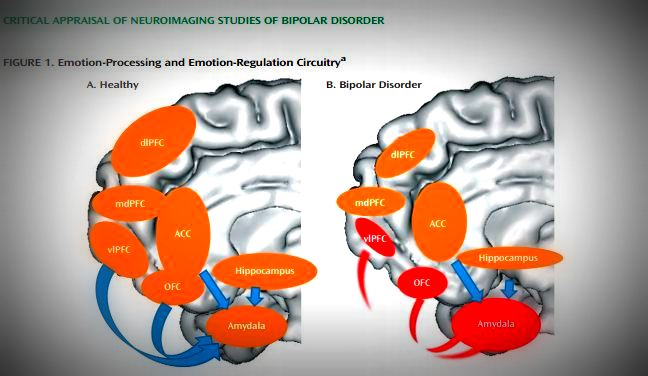Phillips and Swartz

A Critical Appraisal of Neuroimaging Studies of Bipolar Disorder:
Toward a New Conceptualization of Underlying Neural Circuitry and a Road Map for Future Research
Phillips ML and Swartz HA
American Journal of Psychiatry, 171:829-43, 2014
In an effort to synthesize the current knowledge of the neural underpinnings of bipolar disorder and provide a neuroimaging research road map for future studies, Drs. Mary Phillips and Holly Swartz appraised neuroimaging findings in bipolar disorder in emotion-processing, emotion-regulation, and reward-processing neural circuitry.
Drs. Phillips and Swartz reviewed findings from all major studies in bipolar disorder that used functional MRI, volumetric analysis, diffusion imaging, and resting-state techniques, integrating findings with the goal of providing a better understanding of larger-scale neural circuitry abnormalities in bipolar disorder.
In neural circuitry terms, bipolar disorder can be conceptualized as parallel dysfunction in prefrontal cortical (especially ventrolateral prefrontal cortical)-hippocampal-amygdala emotion-processing and emotion-regulation circuits bilaterally, together with an "overactive" left-sided ventral striatal-ventrolateral and orbitofrontal cortical reward-processing circuitry, resulting in characteristic behavioral abnormalities associated with bipolar disorder: emotional lability, emotional dysregulation, and heightened reward sensitivity. A potential structural basis for these functional abnormalities is gray matter volume decreases in the prefrontal and temporal cortices, the amygdala, and the hippocampus and fractional anisotropy decreases in white matter tracts connecting prefrontal and subcortical regions.
Neuroimaging studies of bipolar disorder clearly demonstrate abnormalities in neural circuits supporting emotion processing, emotion regulation, and reward processing. However, there are several limitations to these studies. To address those limitations, Drs. Phillips and Swartz concluded that future neuroimaging research in bipolar disorder should include studies adopting dimensional approaches and that larger studies examining neurodevelopmental trajectories in youths with bipolar disorder or at risk for bipolar disorder are needed. Their review also indicates the need for multimodal neuroimaging studies using integrated systems approaches, and studies using pattern recognition approaches to provide clinically useful individual-level data. Future studies focusing on these areas will help to identify clinically relevant biomarkers to guide diagnosis and treatment decision making for individuals with bipolar disorder.
Contributors:
Mary L. Phillips, MD, MD (CANTAB) and Holly Swartz, MD (University of Pittsburgh Department of Psychiatry)
This article appeared in the American Journal of Psychiatry. Click here to view the abstract.
